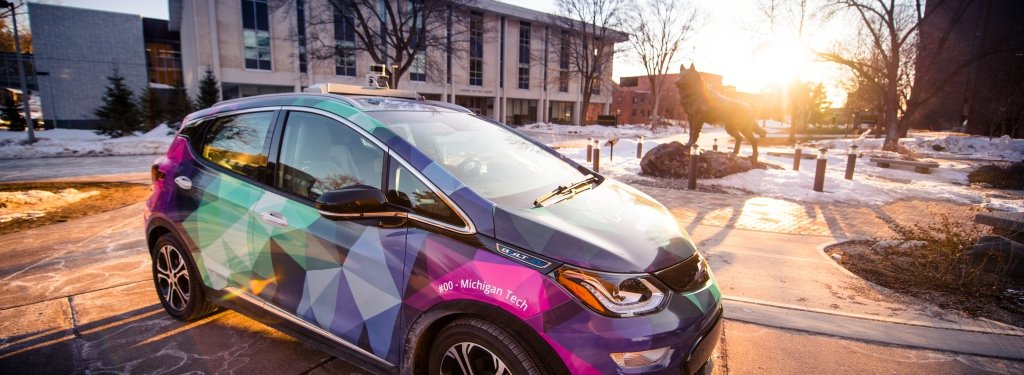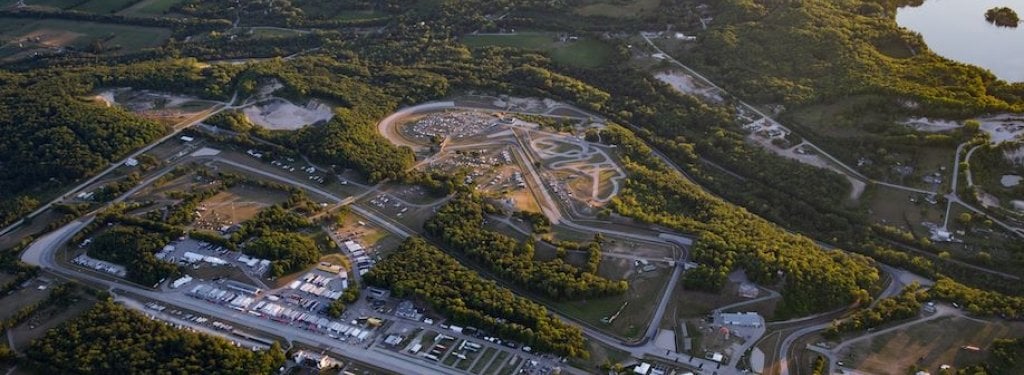Autonomous vehicles hold a lot of promise. But what about in rural communities? Undergraduate students look into the environmental, social and economic impacts of advanced vehicle technology.
Three engineers. Four non-engineers. Together they wrote a report on the social and human aspects of the autonomous technology development as a part of the AutoDrive Challenge. The report is a requirement in the new collegiate challenge and the students wrote it as a part of their Seminar in Sustainability: Renewable Energy and Alternative Fuels class with Roman Sidortsov, assistant professor of energy policy at Michigan Technological University.
While the engineering students from the Robotics Systems Enterprise grapple with the challenges of syncing sensors and designing vehicle communication systems, Sidortsov's crew tackled the fundamental questions around the social impact and acceptance of autonomous vehicles.
The competition organizers tasked the students with figuring out environmental, social and economic impacts of the cars, as well as making a case for autonomous electric vehicles. Sidortsov says that his students dug into new aspects of these questions, focusing on rural communities.
"How can we prevent alienating rural America even more with expensive autonomous vehicles?" Sidortsov asks. "Our work shows it comes down to putting communities first and building technology around their needs."
Two students from the class—Kyla Valenti and Cameron Burke—will be presenting the report at the AutoDrive Challenge competition in Arizona later this month.
Interdisciplinary from the start
Other researchers are tackling the moral, ethical and social conundrums of autonomous tech, too. Sidortsov points out that MIT uses an algorithm—a kind of artificial morality—built on deep learning and big datasets.
"My students went and talked to real people," he says, explaining that the report employed complementary social science methods, a survey and two focus groups organized around parents and the elderly. Because the work is done in tandem with the technical side, it is more relevant and insightful from the start. "Social implications and human implications are the starting point of every technology. Context matters."
When asked what context surprised them, the students were intrigued by the tension of their participants' fear of new technology woven through with excitement for new possibilities. An example worth highlighting is rural ridesharing—like the local foods movement and community-supported agriculture for self-driving cars—which minimizes individual costs while maximizing access, vehicle use and fuel economy. It is also like grassroots efforts to encourage voting and other civic engagement; people are thinking not just about abstract ideas, but how to make a difference in their communities given real challenges.
"Our focus groups were enthusiastic but wary. People told us, 'If they can't fix the potholes, how can we trust they'll maintain autonomous cars?'"
Environmental impacts: Wildlife, land use, saving fuel
Autonomous and electric vehicles can greatly reduce fuel consumption and it's considered a motivation for many hybrid and electric car purchases. (Check out how the Advanced Power Systems Labs is taking it to the next level with NEXTCAR.) But the parents focus group pointed out that the real impact depends on how the vehicles are actually used, and how often.
Some environmental impacts are less obvious—especially in urban settings. One major rural impact could be reducing collisions with wildlife. But for the number of deer and other critters saved, habitat and land use could be altered with changing infrastructure. The mere idea of change led to a few salty responses on the class' survey.
"We gave people space to write in responses on our survey—and some people threw that back at us. They said we don't know what the impact is going to be on our community, why are you asking us when you should be telling us because you're the researcher."
Social impacts: Concern and excitement over self-driving cars dominate the conversation
Safety is the driving force behind people's concerns with autonomous vehicles. Ironically, they could make driving a much safer activity—but the novelty of the technology changes people's perceptions.
"We've accepted automobile deaths as a norm. Because autonomous vehicles are new, we're suspicious of any accidents—it comes down to people's sense of control."
Safety ethics usually get presented in the classic "Trolley Problem" format: a kid is about to get hit by a streetcar; by killing another pedestrian, the kid could be saved. In autonomous tech, the question comes down to who the vehicle should save and how that risk is calculated. The trolley discussion can be limiting, however; it's extreme and most real-world scenarios are not when it comes to autonomous vehicles.
For the students, acknowledging the inherent gray space between the yellow lines of autonomous roads emphasized the unique challenges for rural communities. In particular, during their discussions with the elderly focus group, the team realized how much current vehicle systems limit some groups. Autonomous vehicles—especially community-owned ones—could make travel available to groups like the elderly and students without cars.
"How we commercialize tech often does not consider the impacts on marginalized communities."
But, of course, participants had questions about what owning an autonomous vehicle would really mean. Especially in terms of their pocketbooks.
Economic impacts: For rural communities, purchasing is a challenge and ridesharing is viable
A semi-autonomous vehicle on the market today runs for $80,000 to $100,000. You can buy a nice house in Hancock for that much. Plus, people find it difficult to put a price on the experiences and pride they invest in their cars. In the Keweenaw—and most likely other rural communities with a strong outdoorsy streak—abandoning Google maps and getting off the beaten path is important. More than one participant asked, how will I get to my camp? And how the heck would an autonomous car deal with an unplowed backroad?
"Even if you have a great autonomous vehicle, and its algorithms, its hardware are good enough to run even in this environment [waves hand to window], people were still concerned about them; they didn't seem interested at all in a car that didn't have a steering wheel."
Even though researchers are working on those challenges, the likelihood is low for autonomous vehicles that are individually owned, camp-trekking, blizzard busting and spacious enough for the family dog. That's why the team looked into the potential for co-use and co-ownership models such as ridesharing.
The economics of it are simple and would be something like a mix of ZipCars and Uber; a municipality would own a fleet and rent them out. For rural communities—and even snowy remote communities like the Keweenaw—autonomous vehicles offer the chance to rethink transportation access and safety.
"Mobility is about access to opportunity."
Michigan Technological University is an R1 public research university founded in 1885 in Houghton, and is home to nearly 7,500 students from more than 60 countries around the world. Consistently ranked among the best universities in the country for return on investment, Michigan's flagship technological university offers more than 120 undergraduate and graduate degree programs in science and technology, engineering, computing, forestry, business, health professions, humanities, mathematics, social sciences, and the arts. The rural campus is situated just miles from Lake Superior in Michigan's Upper Peninsula, offering year-round opportunities for outdoor adventure.






Comments